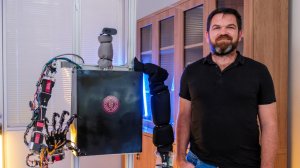The Stellenbosch University (SU) Department of Electrical and Electronic Engineering has launched a humanoid robotics research platform to showcase advanced robotics technology.
The humanoid robot currently stands at full height, featuring a functional torso and a fully operable right arm and hand, while its left arm is nearing completion.
To enhance its human-like capabilities, the robot features a webcam for vision tracking, paired with advanced software that enables the robot to analyse and mimic human movements in real-time.
“Our system can perform inverse kinematics, enabling it to accurately follow the motions of a human operator,” says SU Department of Electrical and Electronic Engineering lecturer Dr William Duckitt.
“The platform can be theoretically teleoperated from anywhere in the world, highlighting its potential for remote operation.”
The next stage of research will concentrate on developing actuators for the robot’s legs, with the goal of achieving bipedal walking. This advancement represents a critical step toward a fully mobile humanoid robot capable of realistic human movement and interaction.
Owing to the future potential of humanoid robotics, the department is actively involving students in innovative projects.
Several undergraduate final-year projects are underway, focused on the design and development of custom actuators, advanced robotic hands, and humanoid arms with pincer grips, providing students with hands-on experience.
“We aim to cultivate a new generation of researchers who will transition to master’s programmes and deepen their contributions to this field,” Duckitt notes.
Additionally, a master’s student is currently working on virtual robotics simulations using the computer chip maker Nvidia IsaacSim platform.
This research is focused on achieving sim-to-real transfer, which is a technique that will initially apply simulation results to the robot arm prototype and, ultimately, help refine the functionality of the entire humanoid platform.
The platform, built using the EtherCAT communication protocol, supports both synchronous and asynchronous processes.
“This design allows us to tackle complex tasks with ease, leveraging technology I have used in particle accelerator control systems,” says Duckitt.
“Our journey in humanoid robotics combines our engineering expertise with an academic ambition to push the boundaries of what’s possible,” he adds.
Edited by: Creamer Media Reporter
EMAIL THIS ARTICLE SAVE THIS ARTICLE
ARTICLE ENQUIRY
To subscribe email subscriptions@creamermedia.co.za or click here
To advertise email advertising@creamermedia.co.za or click here













